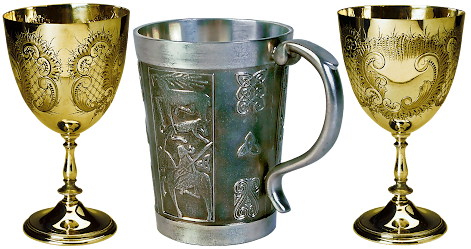At the same time of the Arab conquest in the 7th century A.D., glass making had flourished in Egypt and western Asia. For more than two thousand years and glassmakers in those regions have been doing business in spite of the dramatic political, social, and religious changes taking place around them. The glassmakers inherited many of their ancestral techniques in the Byzantine and Sasanian empires, including the piercing of glass, the use of the mold, the use of molten glass with tools, and the decoration of molten glass. The manufacture of Islamic glass from the 7th to the 14th century also invented new inventions and was witnessed by the glorious stages, which established its magnitude in producing glass around the world.
While many of the objects may not have been made under a ruler's patronage, they certainly are ''fit for a sultan''.Islamic glass can be better studied according to its handling techniques from unadorned decorative vessels to Moses' glass in pottery, hot, cut, and carved, although ships were manufactured after the 17th century and heavily influenced by Europe.
In the field of Islamic art, glass is a work of art that often rises but is often overlooked by art historians. The 1,000 unknown glassmakers, who travel from Cairo to Delhi, proudly pass on their knowledge from one generation to the next, experimenting with the colors, shapes, techniques, and embellishments of this vast variety. Their outstanding results, from the public to private collections around the world, promote a wide range of knowledge of the art forms of Islamic glass, a worthy legacy to this ancient artwork.
Enameled And Gilded Glass:
The enameled and horizontal glass is the most famous and historically Islamic glass of history. The production of such glass was the specialty of regions controlled by the Ayyubids and the Mamluks in the 13th and 14th centuries. For this decoration, gold and enamels were applied to the glass surface using oil and a brush or reed pen. Because the gilt colors and individual coatings have different chemical properties, different temperatures are required to permanently fix them to the glass. Simultaneous coloring and remodeling can put the ship in regeneration several times and endanger the deformity of its structure, so it is possible that Mamluk glassmakers learn the product when they apply all the colors at once and fix it during a single shot in Kiln without merging.
 |
Gilded Glass |
The vast amount of fossil record indicates that such vessels were highly prized and were probably used for special occasions. The sheer number of pieces available, however, suggests that the product was not only court-sponsored but also for commercial purposes. These unpainted areas of these objects and the favors of Mamluk painters and literary enthusiasts make this type of Islamic glass very instructive, helping scholars to establish chronology and delivery.
Enameled and gilded glass developed in the 12th century in the Syrian area and flourished during the final decades of Ayyubids power and the first of Maluk domination in the 13th century. When Cairo became the capital of the empire in the 14th century, stained-glass and stained glass from that time were probably made in Egyptian workshops, rather than in Syria. The late 14th century saw a decline in production, by the early 15th century, decreasing support eventually caused workshops to close. By the end of the 15th century, large-scale glass production had shifted from Europe to Venice, in particular. The combination of economic, political, and artistic elements may have caused the disappearance of stained glass from the Islamic world.





👍🏻
ReplyDeletehttps://edufacts.life
ReplyDeletegreat
ReplyDeleteGood article
ReplyDeleteNicely written